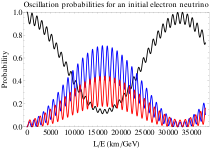22°07′06″N 112°31′07″E / 22.11827°N 112.51867°E / 22.11827; 112.51867
The Jiangmen Underground Neutrino Observatory (JUNO) is a medium baseline reactor neutrino experiment under construction at Kaiping, Jiangmen in Guangdong province in Southern China. It aims to determine the neutrino mass hierarchy and perform precision measurements of the Pontecorvo–Maki–Nakagawa–Sakata matrix elements. It will build on the mixing parameter results of many previous experiments. The collaboration was formed in July 2014 and construction began January 10, 2015. Funding is provided by a collaboration of international institutions. Originally scheduled to begin taking data in 2023, as of October 2024, the US$376 million JUNO facility is slated to come online in the latter half of 2025.
Planned as a follow-on to the Daya Bay Reactor Neutrino Experiment, it was originally to be sited in the same area, but the construction of a third nuclear reactor (the Lufeng Nuclear Power Plant) in that region would disrupt the experiment, which depends on maintaining a fixed distance to nearby nuclear reactors. Instead it was moved west to a site (Jingji town, Kaiping, Jiangmen) located 53 km from both of the Yangjiang and Taishan nuclear power plants.
Detector
The main detector consists of a 35.4 m (116 ft) diameter transparent acrylic glass sphere containing 20,000 tonnes of linear alkylbenzene liquid scintillator, surrounded by a stainless steel truss supporting approximately 43,200 photomultiplier tubes (17,612 large 20-inch (51 cm) diameter tubes, and 25,600 3-inch (7.6 cm) tubes filling in the gaps between them), immersed in a water pool instrumented with 2400 additional photomultiplier tubes as a muon veto. As of 2022, construction of the detector is well underway. Deploying this 700 m (2,300 ft) underground will detect neutrinos with excellent energy resolution. The overburden includes 270 m of granite mountain, which will reduce cosmic muon background.
The much larger distance to the reactors (compared to less than 2 km for the Daya Bay far detector) makes the experiment better able to distinguish neutrino oscillations, but requires a much larger, and better-shielded, detector to detect a sufficient number of reactor neutrinos.
Physics

The main approach of the JUNO Detector in measuring neutrino oscillations is the observation of electron antineutrinos (
ν
e) coming from two nuclear power plants at approximately 53 km distance. Since the expected rate of neutrinos reaching the detector is known from processes in the power plants, the absence of a certain neutrino flavor can give an indication of transition processes.
The quantitative part of the experiment requires measuring neutrino flavour oscillations as a function of distance. This seems impossible, as both the reactors and detector are completely immovable, but the speed of oscillation varies with energy (details at Neutrino oscillation § Propagation and interference). As the reactors emit neutrinos with a range of energies, a range of effective distances can be observed, limited by the accuracy with which each neutrino's energy can be measured.
Although not the primary goal, the detector is sensitive to atmospheric neutrinos, geoneutrinos and neutrinos from supernovae as well.
Expected sensitivity
Daya Bay and RENO measured θ13 and determined it has a large non-zero value. Daya Bay will be able to measure the value to ≈4% precision and RENO ≈7% after several years. JUNO is designed to improve uncertainty in several neutrino parameters to less than 1%.
See also
References
- He, Miao (9 September 2014). Jiangmen Underground Neutrino Observatory (JUNO) (PDF). Neutrino Oscillation Workshop. Conca Specchiulla (Otranto, Lecce, Italy). Page 9 shows a topographical overview of the complex, with a distinctive C-shaped lake near the top of the figure. The lake is clearly the one at 22°07′30″N 112°30′34″E / 22.1250°N 112.5095°E / 22.1250; 112.5095 (Lake near JUNO). Scaling and aligning the image with a map places the experiment at the stated coordinates.
- Ciuffoli, Emilio; Evslin, Jarah; Zhang, Xinmin (August 2013). "The Neutrino Mass Hierarchy from Nuclear Reactor Experiments". Physical Review D. 88 (3): 033017. arXiv:1302.0624. Bibcode:2013PhRvD..88c3017C. doi:10.1103/PhysRevD.88.033017. S2CID 119233801.
- ^ Li, Yu-Feng; Cao, Jun; Wang, Yifang; Zhan, Liang (16 July 2013). "Unambiguous determination of the neutrino mass hierarchy using reactor neutrinos". Physical Review D. 88 (1): 013008. arXiv:1303.6733. Bibcode:2013PhRvD..88a3008L. doi:10.1103/PhysRevD.88.013008. S2CID 118409330.
- "JUNO International Collaboration established". Interactions NewsWire. 30 July 2014. Archived from the original on 21 June 2016. Retrieved 12 January 2015.
- ^ "Groundbreaking at JUNO" (Press release). IHEP. 10 January 2015. Retrieved 12 January 2015 – via Interactions NewsWire.
- JUNO website, 2022-07-23, Guo, Cong (2019-10-23). "Status of the Jiangmen Underground Neutrino Observatory". arXiv:1910.10343 .
- Conroy, Gemma (15 March 2024). "China's giant underground neutrino lab prepares to probe cosmic mysteries". Nature. Vol. 627, no. 8005. pp. 715–716. doi:10.1038/d41586-024-00694-5.
- ^ Stock, Matthias Raphael (December 2023). Status and Prospects of the JUNO Experiment. The 17th International Workshop on Tau Lepton Physics. Louisville, Kentucky. arXiv:2405.07321.
- "Inside the underground lab in China tasked with solving a physics mystery". Reuters. 16 October 2024. Retrieved 19 November 2024.
- ^ Wang, Yifang (24 June 2014). JUNO Experiment (PDF). International Meeting for Large Neutrino Infrastructures. Paris.
- Xiao, Mengjiao (3 November 2016). UNO central detector and calibration strategy (PDF). International Workshop on Next Generation Nucleon Decay and Neutrino Detectors (NNN16). Beijing, China.
- Ji, Li (April 28, 2022). "Underground neutrino experiment facilities under construction in Guangdong". China News Service (ECNS). Retrieved 28 April 2022.
- ^ "Introduction to JUNO". JUNO at IHEP. 2013-09-12. Archived from the original on 2014-12-02. Retrieved 2015-01-12.
- Li, Yu-Feng (25 Feb 2014). "Overview of the Jiangmen Underground Neutrino Observatory (JUNO)". International Journal of Modern Physics: Conference Series. 31: 1460300. arXiv:1402.6143. Bibcode:2014IJMPS..3160300L. doi:10.1142/S2010194514603007. S2CID 118556513.
External links
- Jiangmen Underground Neutrino Observatory web site
- JUNO at Shanghai Jiao Tong University
- JUNO documents at INFN
- T. Adam; et al. (20 September 2015). "JUNO Conceptual Design Report". arXiv:1508.07166 .
| Neutrino detectors, experiments, and facilities | |||||||||||||
|---|---|---|---|---|---|---|---|---|---|---|---|---|---|
| Discoveries |
| ||||||||||||
| Operating (divided by primary neutrino source) |
| ||||||||||||
| Construction | |||||||||||||
| Retired | |||||||||||||
| Proposed | |||||||||||||
| Cancelled | |||||||||||||
| See also | |||||||||||||